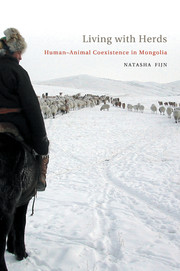Book contents
- Frontmatter
- Contents
- Lists of Plates, Figures, Maps, Tables, and Online Video Segments
- Glossary
- Acknowledgments
- LIVING WITH HERDS
- PART ONE CROSSING BOUNDARIES
- PART TWO THE SOCIAL HERD
- 3 SOCIAL SPHERES
- 4 NAMES, SYMBOLS, COLOURS, AND BREEDING
- 5 MULTISPECIES ENCULTURATION
- 6 TAMENESS AND CONTROL
- PART THREE LIVING WITH HERDS
- Appendix
- References
- Index
- Plate section
3 - SOCIAL SPHERES
from PART TWO - THE SOCIAL HERD
Published online by Cambridge University Press: 03 May 2011
- Frontmatter
- Contents
- Lists of Plates, Figures, Maps, Tables, and Online Video Segments
- Glossary
- Acknowledgments
- LIVING WITH HERDS
- PART ONE CROSSING BOUNDARIES
- PART TWO THE SOCIAL HERD
- 3 SOCIAL SPHERES
- 4 NAMES, SYMBOLS, COLOURS, AND BREEDING
- 5 MULTISPECIES ENCULTURATION
- 6 TAMENESS AND CONTROL
- PART THREE LIVING WITH HERDS
- Appendix
- References
- Index
- Plate section
Summary
Just as a human can live as a hunter-gatherer or in a prison cell, so a cow can live as a free-ranging grazer or in a factory farm. But neither the human nor the cow actually changes their inherent behavioural impulses or their innate powers of perception, although these may be suppressed by lack of opportunity.
(Clutton-Brock 1994: 30)INTRODUCTION
The domestic sphere of the encampment does not have sharp boundaries; people and animals move within and beyond this sphere frequently, but most of the herders' and herd animals' time and energy are spent within this co-domestic sphere. In the first part of this chapter I describe the importance of the social landscape of the herding encampment as the central sphere for establishing the co-domestic relationship between herding family and herd animals. Much of the herders' and herd animals' world is focused upon this core encampment, even though the location of the encampment itself migrates and changes with the seasons. The encampment is, therefore, not a fixed space that can be quantitatively measured; both people and animals inhabit it as an ecosocial sphere. Richard Nelson (1983: 243) describes a similar interweaving of life histories into the surrounding landscape in relation to the Koyukon people: “Each living individual is bound into this pattern of the land and people that extends throughout the terrain and far back across time.”
- Type
- Chapter
- Information
- Living with HerdsHuman-Animal Coexistence in Mongolia, pp. 55 - 80Publisher: Cambridge University PressPrint publication year: 2011



